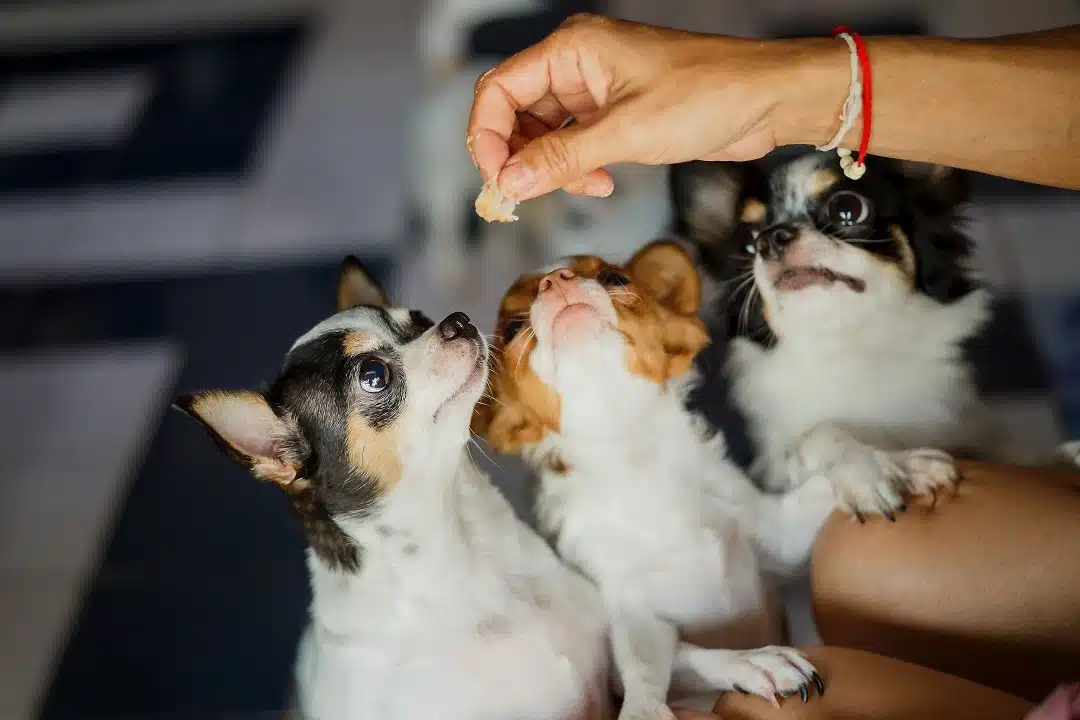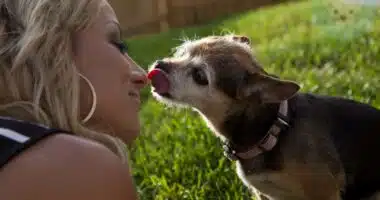You’ll want to put careful thought into what you feed your Chihuahua. This breed is very sensitive to what they are being fed, how often they eat, and in which manner their food is offered to them. In fact, the food that you choose for your Chihuahua for both meals and snacks will directly affect your puppy or dog’s health status, both now and in the future.
With a very low tolerance for chemicals (artificial coloring and preservatives) and a need for the right balance of protein, healthy fats, and essential carbs, you may need to do a little experimenting to see what type of food ingredients your Chihuahua enjoys the most and which are best tolerated by their digestive system.
Aren’t you looking for all the details, and just want to know exactly what to feed your Chihuahua? Jump to: The Best Dog Food for Chihuahuas.
There may be some times when you wish to change your Chi’s food, for example when you first bring a new puppy home, if your Chihuahua is finicky or doesn’t seem to be thriving on their current diet, or if there is an intolerance or allergy.
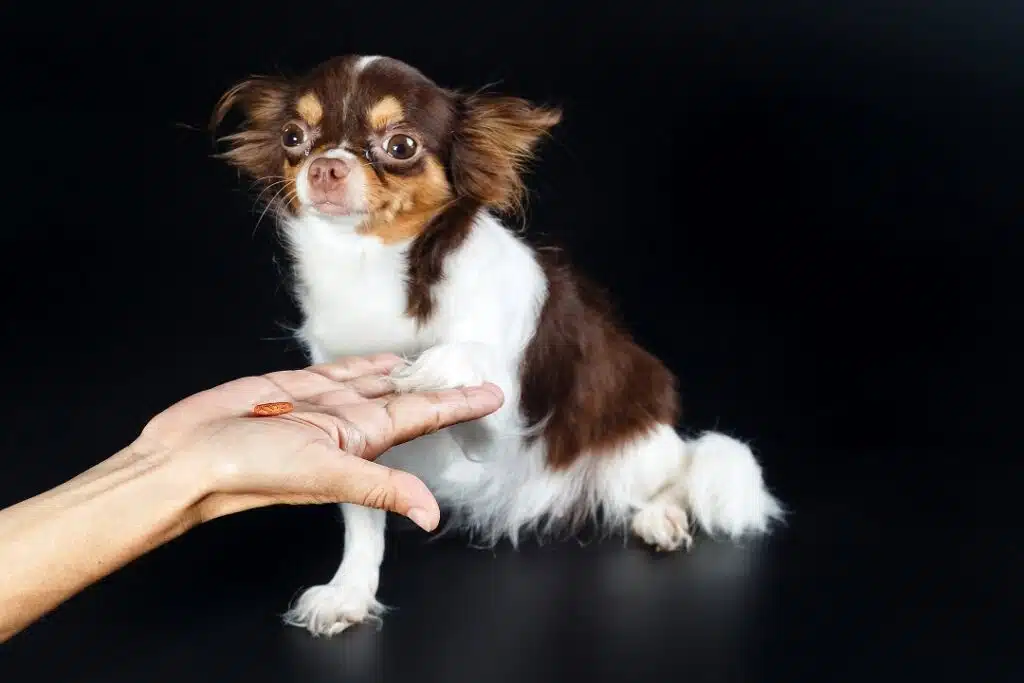
Though making a switch to a new food certainly may be warranted, unless it is an urgent situation, it is best to do so gradually. This is typically done in this way:
- Week One: 3/4 old food, 1/4 new food – mixed together well
- Week Two: 1/2 old food, 1/2 new food – mixed together well
- Week Three: 1/4 old food, 3/4 new food – mixed together well
- How Often to Feed a Chihuahua – Meal Schedule
- Toy breeds like the Chihuahua do best with small, frequent meals. The exact timing and frequency will depend on age:
Puppies until 3 months old or under 2 lbs.: Free-feeding is recommended. is the method of leaving food accessible at all times, around the clock. Be sure that food is refreshed several times per day so that it does not become dried out or stale.
All Chihuahua puppies and adults, from 3 months on (with a weight of at least 2 lbs.): Most Chihuahua do best with 3 meals per day, plus several snacks in between meals.
Meal Schedule Tips:
When you are feeding 3 meals per day, there is a good chance that you will not be home for the mid-day feeding. You can leave food in a dish for your Chi, though do keep in mind that this may be played with instead of eaten, or it can be tipped over and scattered.
So, another great alternative option is to leave a meal’s worth of food in a treat-dispensing toy. This serves two purposes: It ensures that your Chihuahua will indeed have access to his food, but it also works to keep a dog busy. And when a dog is home alone, keeping your dog busy is a great goal.
While Kongs are the traditional method to do this, even the smallest one is a bit too large for most Chihuahua puppies, and even adults can struggle with it.
A better option is the PetSafe Busy Buddy Barnacle Dog Toy – Extra Small which is a cluster of 3 tiny balls that dispense food. This works very well for most Chihuahuas.
And another great choice is the PetSafe Busy Buddy Twist ‘n Treat – Extra Small. This looks like a tiny flying saucer and you can adjust how loose or tight the holding compartments are for an easy release or one that your Chihuahua has to really work for (to stay busy longer).
You will find that the timing of the evening meal affects the timing of your Chihuahua’s morning bowel movement. So, you may want to adjust this earlier or later by an hour or so, depending on your Chi’s bathroom needs in the morning.
How Much to Feed a Chihuahua Calories:
The right amount of food to give to a Chihuahua depends on that puppy or dog’s individual calorie requirements.
This can vary quite a bit and fluctuate daily, and depends on a dog’s activity level, exact age, health status, and even the weather (dogs tend to eat more in the winter).

In general, the calorie requirements for puppies are about 50 calories per pound of body weight and for adult Chihuahuas, it is 35 to 40 calories per pound of body weight.
Measured food: The right serving size for Chihuahuas also varies depending on what type of food is given (wet vs dry, chicken vs beef, high-quality vs mediocre, etc.). But, in general, you can expect a Chihuahua to eat a very small amount (especially compared to this breed’s larger counterparts and most definitely to us humans).
Chihuahuas that range in size from 4 to 10 pounds will eat approximately 1/2 to 1 and 1/3 cups per day (split into however many meals you are providing, which in most cases should be three).
You didn’t read that wrong; this is a very tiny breed that does need to be fed a high-quality food but does not eat a lot. There are very few Chihuahuas that eat over 2 cups per day; and those that do tend to be the ones that are larger than the standard size.
In most cases, the feeding guidelines seen on the packaging of dog food is pretty spot-on; it is determined by both age and weight and assumes you are offering several snacks per day.
The Importance of a Balanced, Nutritious Diet
Keeping your Chihuahua healthy begins by offering the best of food possible. What a puppy or dog eats correlates to many aspects.
The quality of food offered will affect energy levels and muscle maintenance, and have a direct effect on both short and long-term health. A dog’s diet is linked to skin and coat health, organ and immune system health, and conditions such as canine diabetes, heart disease, and some forms of cancer.
There are some dog food ingredients that are linked to certain behavioral issues like hyperactivity, so this is always something to be aware of as well.
In addition, intolerance or allergy to food ingredients or additives can cause a wide range of issues including itching, rash, hives, hot spots, and digestive problems.
It’s easy to spot a Chihuahua that’s being fed great food; the coat is shiny, skin issues are non-existent, eyes are shiny, energy-levels are good, and the dog is simply thriving.
Grain vs Grain-free
For quite some time, there was generally no hesitation in putting dogs on a grain-free diet. This was often the way to go for a suspected grain (or more often, gluten) intolerance. In some cases, this helped resolve skin issues like itching or stomach problems like flatulence or runny bowels.
However, recently some concerns have been raised. This began when four dogs that are not known to be prone to a certain heart condition called dilated cardiomyopathy (DCM) developed the disease and all were on grain-free diets that had peas, lentils, other legume seeds, or potatoes as one of the top 5 ingredients. This lead to an immediate suspicion that there was a link to that sort of diet, but more studies needed to be done.
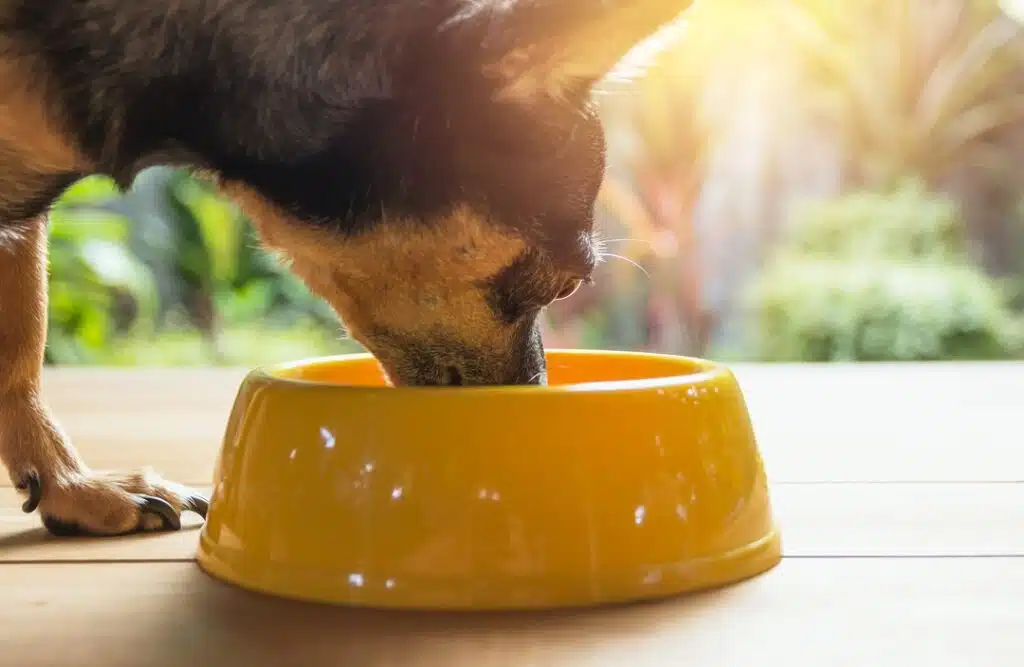
Though records go back several years, mostly over the past two years over 500 dogs have been diagnosed with DCM while on a grain-free diet. Of those, just two were identified as Chihuahuas. This is enough to take note, but is a very small number compared to the estimated 77 million dogs in the US.
In December of 2018, researchers at the Veterinary Medical Center at Tufts University announced that what may actually be at play is a BEG diet; which stands boutique (small locally owned brands) with exotic meats (non-traditional meats such as alligator, kangaroo, bison, ostrich, and venison) that is also grain-free while having peas, lentils, other legume seeds, or potatoes as one of the top 5 ingredients.
At the end of June of 2019, the FDA issued an alert that contained a list of 16 dog food brands whose grain-free recipes were linked 10 or more times to the dogs that had developed DCM. They are:
- Acana (67 reports)
- Zignature (64 reports)
- Taste of the Wild (53 reports)
- 4Health (32 reports)
- Earthborn Holistic (32 reports)
- Blue Buffalo (31 reports)
- Nature’s Domain (29 reports)
- Fromm (24 reports)
- Merrick (16 reports)
- California Natural (15 reports)
- Natural Balance (15 reports)
- Orijen (12 reports)
- Nature’s Variety (10 reports)
- Nutrisource (10 reports)
- Nutro (10 reports)
- Rachael Ray Nutrish (10 reports)
As of now, there have not been any recalls. This is still under investigation and many more studies need to be completed; it could be years before anything conclusive is released.
For the time being, most veterinarians recommend a diet with grains (that are gluten-free, if needed, like rice, quinoa or oats) or sticking with traditional meats (chicken, duck, turkey, beef, etc.) if you opt to offer grain-free.
Below in our lists of The Best Dog Food for Chihuahuas, you’ll see options for both grain-free and grains.
Things Seen in Low-Quality Food
There are a lot of different dog foods on the market, and only a small percentage can be considered to be the best. The rest cut many corners in order to mass-produce food that will sell a lot, and sell quickly.
What inferior foods most often contain are:
Artificial additives. This includes chemical coloring, flavoring, and preservatives. These can cause a lot of gastrointestinal issues such as diarrhea, upset stomach, and vomiting and are the cause of many allergies with the top symptom being itching and other possible signs being hives, rash, hot spots, and poor coat health. Some coloring dyes are linked to hyperactivity, organ damage, and some forms of cancer (mainly thyroid tumors). Synthetic preservatives are linked to liver and blood problems and some cancers. MSG is linked to anxiety, rapid heartbeat, and breathing issues.
Fillers.
these substances quickly pass right through the body (since they have no nutritional value and the body does not absorb them). This can lead to nutritional deficiencies and behavioral issues such as eating grass or eating feces. These are such things as corn bran, cellulose, oat hulls, peanut hulls, rice hulls, soybean mill run, and wheat mill run.
By-products. These are parts of animals that are deemed unfit for human consumption. This can include beaks, lungs, fatty tissue, intestines, spleens, hooves, snouts, ears, and more.
Generic meat sources. Perhaps one of the scariest ingredients found in inferior foods is generic meat or oils, typically labeled as ‘animal fat’, ‘animal meat’, etc. This means any animal at all, including roadkill and animals that died while being transported to farming or food facilities.
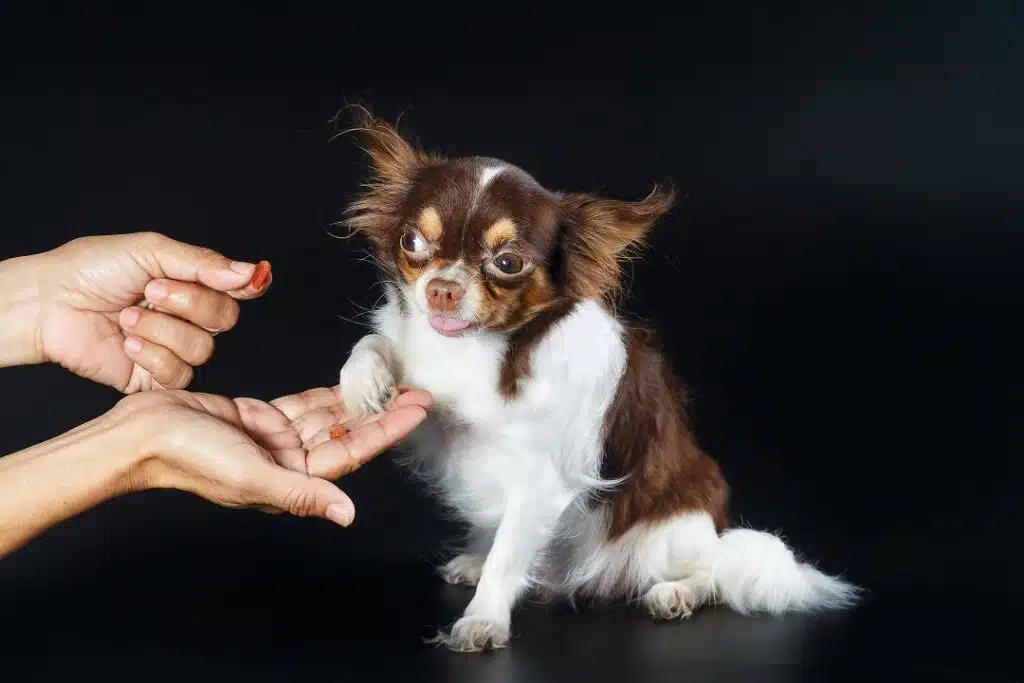
List of Inferior Dog Food Brands
Some of the worst offenders are brands that you are well aware of; they are seen stacked in local supermarkets and pet supply stores, and many air lots of commercials. Pet parents see a recognizable name and assume that since it must be popular, it must be good food. But, this is one mistake you’ll want to avoid.
1-star foods (absolutely horrible):
Alpo, Gravy Train, Kibbles ‘n Bits, Pedigree, Old Glory, Old Yeller, and some varieties Purina Dog Chow.
2-star foods (terrible):
Beneful, some varieties of Blue Buffalo, Cesar (Classic, Savory Delights, Sunrise, and Filet), Evolution, some varieties of Hill’s Science Diet, some varieties of Iams, Mighty Dog (wet), some varieties of Purina Dog Chow, Rachael Ray Nutrish, Royal Canin, Seminole, Trader Joe’s Kibble.
3-star foods (are ‘okay’, but your Chihuahua deserves better):
Back to Basics, some varieties of Blue Buffalo, Candae, Diamond, Eukanuba, Halo Vigor, Hill’s Ideal, some varieties of Hill’s Science Diet, some varieties of Iams, Natural Balance, Nature’s Recipe, Newman’s Own Dog Food, Nutro, many varieties of Purina, some varieties of Rachael Ray, some varieties of Royal Canin, some varieties of Trader Joe’s, Tuscan Natural.
What You’ll Find in The Best Dog Food for a Chihuahua
Some elements you will find in the top brands include:
All-natural. This alone is a huge factor and should be a #1 priority. This means no artificial flavors, coloring, or preservatives. All-natural preservatives generally consist of a vitamin blend (may show as mixed tocopherols and/or certain herbs like rosemary.
Protein is from wholesome, specific traditional meat or fish (USA farmed chicken, lamb, beef, duck and farmed or fresh-caught salmon, whitefish, etc.). Meats can be whole or meal (condensed meat in which moisture is removed, thus creating a protein-dense ingredient)
No cheap fillers (corn, cheap cereal grains, etc.)
Extras like glucosamine and chondroitin (for joint health), probiotics (for digestive health), antioxidants (for immune strength) and good levels of omega fatty acids (for skin and coat health)
Proper protein, carb, fat, and fiber ratios
The Best Dog Food for Chihuahuas
Please note that if you did not yet read over ‘Grain vs Grain-free’ you may wish to do so before proceeding.
Top 2 Recommended Brands, with Grains:
Merrick Classic Small Breed Recipe.
Overview: Merrick is a trusted 4.5-star brand that is made in the USA. This recipe is formulated for dogs as small as 2 lbs. and is an all-natural dog food without wheat that focuses on the classic flavors dogs tend to like. There is also no corn, by-products, or any sort of artificial additives.
Ingredients: This specific recipe has quality grains (oats, brown rice, barley, and quinoa) and a base of chicken and turkey. This blend is typically very easy on the tummy and well-tolerated. Other ingredients include salmon meal (condensed for concentrated protein), peas, chicken livers, carrots, apples, flaxseed oil, blueberries, and chia seeds. All other ingredients are to naturally preserve or flavor the food or are vitamins or minerals.
Major pluses: Great traditional taste, small-sized kibble, added glucosamine and chondroitin (good for joint health), and good levels of omega-3.
Wellness Complete Health Toy Breed Formula.
Overview: This is a top-rated, made in the USA, all-natural dog food formulated for toy breeds that really focus on offering a superior kibble. There is no wheat, corn, by-products, or artificial additives.
Ingredients: The base of this blend is chicken, brown rice, and peas. Other wholesome ingredients include turkey, oatmeal, flaxseed, carrots, spinach, sweet potatoes, blueberries, and apples. All other ingredients are to naturally preserve or flavor the food or are vitamins or minerals.
Major pluses: This is a 100% all-natural dog food that has a simple formula that is generally tolerated quite well, the kibble size is ideal for Chihuahuas, and there’s good levels of glucosamine and chondroitin, omega-3 and 6, and both prebiotics and probiotics which can really aid in good digestion.
Top 2 Recommended Brands, Grain-free:
Halo Grain-Free for Small Breeds Game Bird Medley.
This brand goes a step beyond all-natural by offering an organic formula that includes hormone and antibiotic-free meats and non-GMO produce. There is no wheat, corn, by-products, or artificial additives, and is made in the USA.
Ingredients: This has a base of turkey, duck, and goose with chickpeas and sweet potato. Other ingredients include lentils, flaxseed, salmon oil, blueberries, cranberries, and carrot. All other ingredients are to naturally preserve or flavor the food or are vitamins or minerals.
Major pluses: The organic non-GMO aspect is certainly a plus and this formula is very easily digestible. This particular recipe is the game bird, but they also offer a great holistic chicken and turkey blend, a puppy formula, senior formula, and even a healthy weight blend.
Wellness CORE Grain-Free for Small Breeds.
As a truly top-line formula, this is one of the best foods for Chihuahuas and for very good reasons. It is packed with extras for a superbly healthy diet, sized for small dogs, made in the US, 100% all-natural, and is made with premium proteins and offers a nice selection of both vegetables and fruit.
Ingredients: This has a base of turkey and chicken. Other ingredients include peas, flaxseed, salmon oil, spinach, broccoli, carrots, apples, blueberries, kale, and sweet potatoes. All other ingredients are to naturally preserve or flavor the food or are vitamins or minerals.
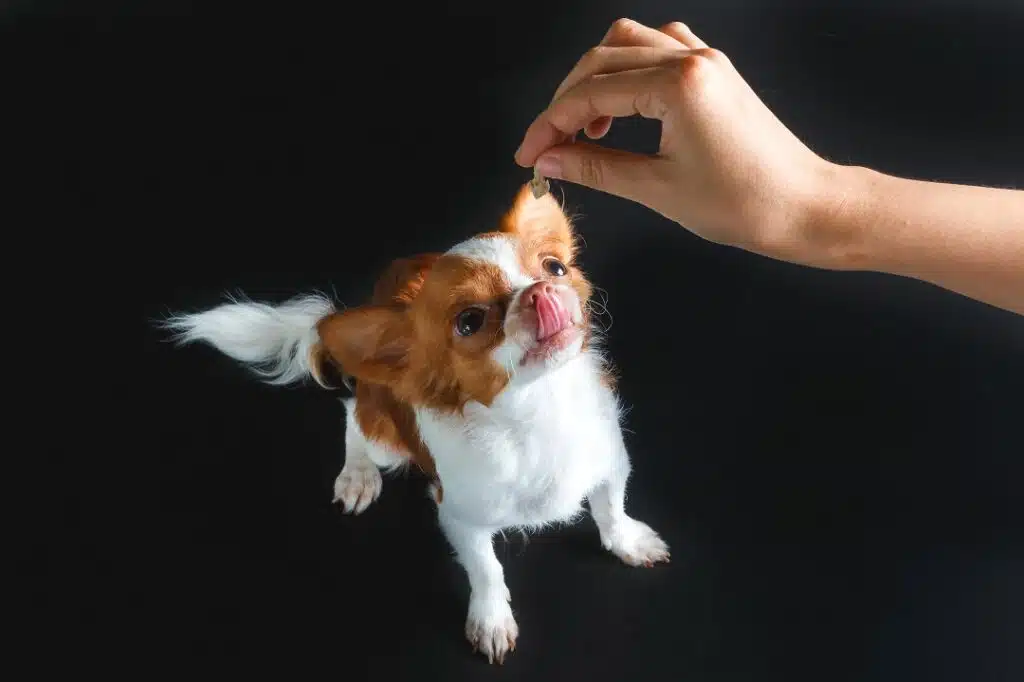
Major pluses: It is very hard to beat this formula; it contains just about everything you’d want your Chihuahua to have for meals and nothing that you don’t. There are good levels of omega-3 and 6, glucosamine and chondroitin, antioxidants, probiotics, and fiber for a well-rounded diet.
Home Cooking Options
Lots of pet parents think about cooking for their dog; especially if there is an intolerance to manufactured food or if a Chihuahua is particularly fussy. This can be a good idea, as long as you include a wide enough range of wholesome ingredients for a well-balanced diet and if you like to spend time in the kitchen. If there are just a few recipes that you’ll be following, you can always meal-prep by cooking just once or twice a week.
Wet Canned Food vs Dry Kibble
If you could ask a dog which they preferred, the vast majority would instantly answer that wet food was the most appealing. That said, between the two, a hard dry kibble is best for dental hygiene as it helps keep teeth and gums strong and healthy. In addition, a purely wet commercial dog food diet can lead to runny bowels.
Chihuahuas are already prone to dental issues, so if you do offer a strictly canned dog food diet, you’ll want to pay even closer attention to dental care than you already do.
If you wish to offer canned food, you may want to consider mixing it with dry kibble or using another method to make kibble more palatable such as drizzling low-sodium broth over it and/or warming it up.
Foods that are Toxic to a Chihuahua (and other dogs)
There are some common human foods that are toxic to canines:
- Onion
- Garlic
- Shallots
- Leeks
- Chives
- Chocolate
- Grapes (also grape jelly and grape juice)
- Raisins
- Currants (also currant jelly)
- Wild Mushrooms
- Pecans
- Walnuts
- Macadamia nuts
- Cherries
- The pits or core from any fruit, and the seeds from apples
- Any food with xylitol (a sugar substitute)
- Any food (or drink) with caffeine
Leaves and other parts of a tomato plant, avocado plant, bell pepper plant, and eggplant plant
Yeast dough
Milk is not toxic but can cause runny bowels and stomach upset.
Picky Eaters
It’s not uncommon for owners to feel that their Chihuahua is not eating enough or doesn’t like his food. However, in most cases, this is just a matter of a Chihuahua needing very little food compared to their humans. Dogs that are deemed fussy or picky, are often just eating the amount that they require.
As we went over earlier, this breed typically eats just 1/2 to 1 and 1/3 cups per day. And of course, this may seem like a terribly small amount. If your Chihuahua puppy is steadily gaining or your adult Chihuahua is maintaining, and you are sure that you are feeding him high-quality food, this means that he is eating the amount he is supposed to be eating.
A sudden change in appetite, however, can be a sign of health issues. If a Chihuahua stops eating, or if appetite decreases to such an extent that a puppy is not gaining or an adult is losing, this is a clear sign that a vet visit is needed.
If your Chihuahua balks at his food, this can be a matter of waiting him out. Maybe he is used to you rushing over to offer something different. Or he may enjoy the attention that he receives when he acts stubborn. If you are sure that you have chosen one of the better foods that is a 4 or 5-star brand, simply place his food down, and leave him to it.

